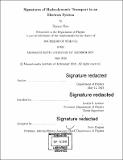Signatures of hydrodynamic transport in an electron system
Author(s)
Guo, Haoyu, S.B. Massachusetts Institute of Technology
DownloadFull printable version (5.728Mb)
Other Contributors
Massachusetts Institute of Technology. Department of Physics.
Advisor
Leonid S. Levitov.
Terms of use
Metadata
Show full item recordAbstract
Electrons in strongly-correlated systems move in a neatly coordinated manner, in many ways resembling the movement of viscous fluids and leading to surprising collective behaviors. Here we explore how the hydrodynamic behavior manifests itself in the electron transport through nanoscale constrictions. Free electron flows through constrictions in metals are often regarded as an ultimate high-conduction charge transfer mechanism. However, as shown in this thesis, interactions can facilitate transport and give rise to super-ballistic conduction, allowing conductance to exceed the ballistic limit value. In other words, interactions and viscous effects, rather than presenting a hindrance for conduction, help increase carrier mobility and suppress dissipation. This interesting behavior represents a clear signature of the electron hydrodynamic regime, and provides a way to determine electron viscosity. These results show that interactions and viscous effects can facilitate high-mobility transport, granting a new route for designing low-power nanoscale devices.
Description
Thesis: S.B., Massachusetts Institute of Technology, Department of Physics, 2018. Cataloged from PDF version of thesis. Includes bibliographical references (pages 63-64).
Date issued
2018Department
Massachusetts Institute of Technology. Department of PhysicsPublisher
Massachusetts Institute of Technology
Keywords
Physics.